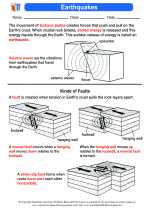Atmospheric Stability
Atmospheric stability refers to the tendency of the atmosphere to resist vertical motion. It plays a crucial role in determining weather patterns and the formation of clouds and precipitation. Understanding atmospheric stability is essential for meteorologists and climatologists to predict weather and climate changes.
Factors Affecting Atmospheric Stability
Several factors affect atmospheric stability, including:
- Temperature: Warmer air is less dense and tends to rise, leading to unstable atmospheric conditions. Cooler air is denser and tends to sink, resulting in more stable atmospheric conditions.
- Moisture: Moist air tends to be less stable than dry air. Water vapor can condense to form clouds, releasing latent heat and further destabilizing the atmosphere.
- Pressure: High-pressure systems generally lead to stable atmospheric conditions, while low-pressure systems tend to be associated with unstable conditions.
Types of Atmospheric Stability
There are three main types of atmospheric stability:
- Stable Atmosphere: In a stable atmosphere, air parcels that are displaced vertically tend to return to their original position. This leads to little vertical movement and can result in clear, calm weather.
- Unstable Atmosphere: An unstable atmosphere allows air parcels to continue rising or sinking once displaced. This can lead to the formation of clouds, thunderstorms, and other convective weather phenomena.
- Neutral Atmosphere: In a neutral atmosphere, air parcels neither rise nor sink significantly when displaced. This often occurs in transitional weather conditions.
Study Guide
To understand atmospheric stability, you should focus on the following key concepts:
- How temperature, moisture, and pressure influence atmospheric stability.
- The characteristics and behaviors of stable, unstable, and neutral atmospheres.
- The impact of atmospheric stability on weather patterns and cloud formation.
- Methods for assessing and measuring atmospheric stability, such as lapse rates and stability indices.
- Real-life examples of how variations in atmospheric stability can lead to different weather phenomena.
By mastering these concepts, you will gain a deep understanding of atmospheric stability and its role in shaping the Earth's climate and weather systems.
.◂Science Worksheets and Study Guides Seventh Grade. Earthquakes
Study Guide Earthquakes
Earthquakes  Activity Lesson
Activity Lesson Earthquakes
Earthquakes  Worksheet/Answer key
Worksheet/Answer key Earthquakes
Earthquakes  Worksheet/Answer key
Worksheet/Answer key Earthquakes
Earthquakes  Worksheet/Answer key
Worksheet/Answer key Earthquakes
Earthquakes  Worksheet/Answer key
Worksheet/Answer key Earthquakes
Earthquakes  Worksheet/Answer key
Worksheet/Answer key Earthquakes
Earthquakes  Vocabulary/Answer key
Vocabulary/Answer key Earthquakes
Earthquakes  Vocabulary/Answer key
Vocabulary/Answer key Earthquakes
Earthquakes  Vocabulary/Answer key
Vocabulary/Answer key Earthquakes
Earthquakes  Vocabulary/Answer key
Vocabulary/Answer key Earthquakes
Earthquakes  Vocabulary/Answer key
Vocabulary/Answer key Earthquakes
Earthquakes  Vocabulary/Answer key
Vocabulary/Answer key Earthquakes
Earthquakes  Vocabulary/Answer key
Vocabulary/Answer key Earthquakes
Earthquakes 

 Activity Lesson
Activity Lesson
 Worksheet/Answer key
Worksheet/Answer key
 Worksheet/Answer key
Worksheet/Answer key
 Worksheet/Answer key
Worksheet/Answer key
 Worksheet/Answer key
Worksheet/Answer key
 Worksheet/Answer key
Worksheet/Answer key
 Vocabulary/Answer key
Vocabulary/Answer key
 Vocabulary/Answer key
Vocabulary/Answer key
 Vocabulary/Answer key
Vocabulary/Answer key
 Vocabulary/Answer key
Vocabulary/Answer key
 Vocabulary/Answer key
Vocabulary/Answer key
 Vocabulary/Answer key
Vocabulary/Answer key
 Vocabulary/Answer key
Vocabulary/Answer key
